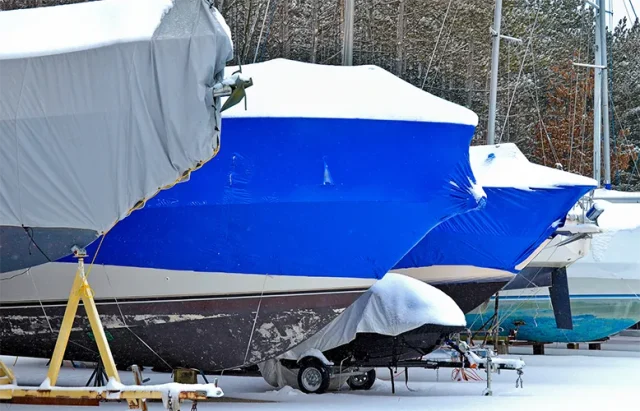
Winterizing your boat is a critical step in ensuring its longevity and maintaining its performance for the next boating season. Properly preparing your boat for winter storage can prevent damage from freezing temperatures, moisture, and inactivity. Are you thinking about getting your boat ready for winter? Follow these steps to winterize your boat and keep it in top condition for the spring season.
Why Winterizing Your Boat is Important
Is going through the hassle of winterizing your boat really worth it? Because boats have complex engine, fuel, and water systems, winterizing your boat is essential to prevent damage caused by freezing temperatures, moisture, and prolonged inactivity. When water freezes, it expands, which can cause cracks in your boat’s engine, plumbing systems, and hull. By properly winterizing, you can avoid costly repairs, preserve your boat’s performance, and extend its lifespan. A well-winterized boat will be ready to hit the water again when the warm weather returns.
Essential Tools and Supplies for Winterizing Your Boat
Before you begin, you’ll want to gather all the necessary tools and supplies needed to get started. Here is a list of recommended supplies for winterizing your boat:
- Boat Cleaner and Wax: A proper boat cleaning kit and marine wax will clean and protect the boat’s deck and hull from dirt, grime, and UV damage during storage.
- Freshwater System Antifreeze: A non-toxic, propylene glycol-based antifreeze is crucial for flushing freshwater and waste systems to prevent freezing and cracking.
- Marine-Specific Fuel Stabilizer: Adding a fuel stabilizer to the fuel tank prevents fuel degradation over the winter months, ensuring the engine runs smoothly when it’s time to use the boat again.
- Engine Flush Kit: An engine flush kit allows you to run fresh water through the engine to remove salt, debris, and other contaminants, which is an important step before draining and adding antifreeze to the cooling system.
- Marine-Grade Lubricants: Applying lubricants to steering systems, throttle cables, and other moving parts prevents rust and ensures smooth operation when the boating season resumes.
- Battery Maintainer: A battery maintainer or trickle charger helps keep the battery at an optimal charge level while it is stored, extending its lifespan and readiness.
- High-Quality Boat Cover: A well-fitted, high-quality cover protects the boat from snow, ice, dirt, and debris during storage, keeping the interior and exterior in top condition.
- Boat Stands or Blocks: If storing the boat on land, boat stands or blocks help support the boat evenly to avoid stress on the hull and prevent moisture damage.
- Moisture Absorbers or Mildew Inhibitors: These products help keep the boat’s interior dry and prevent mold and mildew growth, especially in humid climates.
- Bilge Pump Cleaner: Cleaning the bilge and ensuring that the bilge pump is functioning properly prevents stagnant water buildup and potential freezing issues.
Having these essential tools and products will help ensure a thorough and effective winterization process, protecting your boat from potential damage during the off-season. Now that we have our supplies together, let’s get started.
Step 1: Clean the Boat Inside and Out
Start by giving your boat a thorough cleaning, both inside and out. Remove any personal items, valuables, and perishables. Scrub the hull, deck, and any other exterior surfaces to remove salt, dirt, and debris. Clean the interior, including upholstery, carpets, and storage compartments.
This prevents mold, mildew, and corrosion during the winter months. Consider using moisture absorbers or mildew inhibitors to keep the interior dry and fresh while in storage.
Step 2: Flush the Freshwater and Waste Systems
Flushing and protecting the freshwater and waste systems is a crucial step in winterizing your boat. Begin by draining all freshwater tanks, including water heaters and lines. Next, flush the system with non-toxic, propylene glycol-based antifreeze to prevent freezing and cracking. This step is particularly important for boats stored in regions with freezing temperatures. Similarly, the waste system should be pumped out and flushed with antifreeze to avoid damage to holding tanks and plumbing components.
Step 3: Drain the Engine and Cooling System
To protect the engine from freezing and potential damage, it’s essential to drain the engine and cooling system thoroughly. Start by flushing the engine with fresh water to remove salt and debris. Then, drain any remaining water and fill the engine and cooling system with non-toxic antifreeze to prevent freezing and corrosion. This process helps protect the engine’s internal components and ensures it will be in good working condition come spring.
Step 4: Stabilize the Fuel System
A critical part of winterizing your boat involves stabilizing the fuel system. Fill the fuel tank to reduce the risk of condensation and add a marine-specific fuel stabilizer to prevent fuel degradation over the winter. After adding the stabilizer, run the engine for a few minutes to ensure the treated fuel circulates throughout the system. This step will help prevent issues with fuel quality and engine performance when you’re ready to get back on the water.
Step 5: Remove and Store the Battery
Boat batteries can lose charge and even suffer damage if left in cold conditions. Disconnect the battery and store it in a cool, dry place. Regularly check the charge and use a battery maintainer to keep it at an optimal charge level throughout the winter.
Step 6: Lubricate Moving Parts
Lubricating all moving parts is essential to prevent rust and corrosion during the winter months. Apply marine-grade lubricants to components such as steering systems, throttle cables, and any other moving parts.
Step 7: Protect the Hull and Exterior
Depending on the type of boat, a thorough wax of the boat’s hull and exterior may be necessary to protect against the elements. The wax coating acts as a protective layer against UV rays, water, and ice. Once cleaned and waxed, cover the boat with a high-quality, well-fitted cover to shield it from snow, ice, and debris. This helps prevent damage and keeps your boat looking its best for the next season.
Step 8: Store Your Boat Properly
Finally, make sure your boat is stored properly. Whether on a trailer, lift, or in dry storage, ensure that it is supported evenly to avoid stress on the hull. Consider using blocks or stands to raise the boat off the ground if storing outdoors to prevent moisture damage. An ideal storage environment is a covered, climate-controlled facility, but if that’s not possible, ensure the boat is securely covered and protected from the elements.
Is Your Boat Ready for Winter?
Winterizing your boat is not just about preventing damage; it’s about ensuring your investment remains in great condition for years to come. By following these steps, especially the crucial step of flushing the freshwater and waste systems, you can enjoy peace of mind knowing your boat is well-protected and ready for the next adventure.





